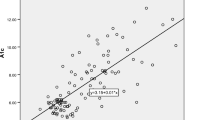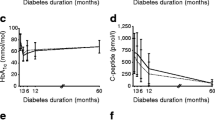Summary
In six children (age: mean 8.4 years, range 2.2–12.6 years) with newly diagnosed Type 1 (insulin-dependent) diabetes mellitus, plasma fructosamine and glycated haemoglobin (HbA1) were compared in respect to their disappearance during the first month after diagnosis during well controlled glycaemia. The disappearance of the surplus plasma fructosamine and HbA1 was calculated applying exponential equations. The estimated half-lives of fructosamine (mean 57.2 days, range 40.7–77 days) and HbA1 (mean 59.7 days, range 43.3–82 days) were not significantly different, a finding which is left unexplained.
Similar content being viewed by others
References
Goldstein DE, Parker KM, England JD, Wiedmeyer HM, Rawlings SS, Hess R, Little RR, Simonds JF, Breyfogle RP (1982) Clinical applications of glycosylated hemoglobin measurements. Diabetes 31 [Suppl 3]: 70–78
Winterhalter KH (1985) Nonenzymatic glycosylation of proteins. Prog Clin Biol Res 195: 109–122
Johnson RN, Metcalf PA, Baker JR (1982) Fructosamme: a new approach to the estimation of serum glycosylprotein. An index of diabetic control. Clin Chim Acta 127: 87–95
Kleihauer E, Kohne E, Niethammer D (1978) Hämatologie. Springer, Berlin Heidelberg New York, p 133
Schultze HE, Heremans JF (1966) Molecular biology of human proteins, Vol 1. Elsevier, Amsterdam New York, p 475
Martin MM, Martin ALA (1976) Continuous low-dose infusion of insulin in treatment of diabetic ketoacidosis in children. J Pediatr 89: 560–564
Schmidt FH (1961) Die enzymatische Bestimmung von Glucose und Fructose nebeneinander. Klin Wochenschr 39: 1244–1247
Flückiger R, Woodtli T, Berger W (1987) Evaluation of fructosamine test for measurement of plasma protein glycation. Diabetologia 30: 648–652
Schnek AG, Schroeder WA (1961) The relation between the minor components of whole normal human adult hemoglobin as isolated by chromatography and starch block electrophoresis. J Am Chem Soc 83: 1472–1478
Weichselbaum TE (1946) An accurate and rapid method for the determination of protein in small amount of blood serum and plasma. Am J Dis Child 16: 40–42
Wincour PH, Bhatnagar D, Reed P, Dhar H (1987) Does the measurement of serum fructosamine accurately reflect levels of glycated albumin in insulin-dependent diabetes? Ann Clin Biochem 24: 47–52
Jury DR, Dunn PJ (1987) Laboratory assessment of a commercial kit for measuring fructosamine in serum. Clin Chem 33: 158–161
Baker JR, O'Connor JP, Metcalf PA, Lawson MR, Johnson RN (1983) Clinical usefulness of estimation of serum fructosamine concentration as a screening test for diabetes mellitus. Br Med 287: 863–867
Baker JR, Johnson RN, Scott DJ (1984) Serum fructosamine concentrations in patients with type II (non-insulin-dependent) diabetes mellitus during changes in management. Br Med 288: 1484–1486
Hindle EJ, Rostron GM, Gatt JA (1985) The estimation of serum fructosamine: an alternative measurement to glycated hemoglobin. Ann Clin Biochem 22: 84–89
Baker JR, Metcalf PA, Holdaway IM, Johnson RN (1985) Serum fructosamine concentration as measure of blood glucose control in type I (insulin dependent) diabetes mellitus. Br Med 290: 352–355
Dolhofer R, Wieland OH (1980) Increased glycosylation of serum albumin in diabetes mellitus. Diabetes 29: 417–422
Mcfarland KF, Catalano EW, Day JF, Thorpe SR, Baynes JW (1979) Non-encymatic glycosylation of serum proteins in diabetes mellitus. Diabetes 28: 1011–1014
Leiper JM, Talwar D, Robb DA, Lunan CB, MacCuish AC (1985) Glycosylated albumin and glycosylated proteins: rapidly changing indices of glycaemia in diabetic pregnancy. Q J Med [55] 218: 225–231
Howey JEA, Browning MCK, Fraser CG (1987) Assay of serum fructosamine that minimizes standardization and matrix problems: use to assess components of biological variation. Clin Chem 33: 269–272, 1955–1956
Stockmann III JA (1981) Hematology manifestations of systemic diseases. In: Nathan DG, Oski FA (eds) Hematology of infancy and childhood, Vol 2. Saunders, Philadelphia London Toronto, pp 1339–1387
McMillan DE, Utterback NG, Mitchell TP (1983) Doublet formation of diabetic erythrocytes as a model of impaired membrane viscous deformation. Microvasc Res 26: 205–220
McMillan DE (1982) Further observations on serum viscosity changing in diabetes mellitus. Metabolism 31: 274–278
McMillan DE (1983) The effect of diabetes o blood flow properties. Diabetes 32 [Suppl 2]: 56–63
Hindle EJ, Rostron GM, Clark SA, Gatt JA (1986) Serum fructosamine and glycated hemoglobin measurement in diabetic control. Arch Dis Child 61: 113–117
Author information
Authors and Affiliations
Rights and permissions
About this article
Cite this article
Mullis, P., Völkle, H., Sigrist, V. et al. Comparison of fructosamine and glycated haemoglobin in children with Type 1 (insulin-dependent) diabetes mellitus. Diabetologia 31, 351–354 (1988). https://doi.org/10.1007/BF02341502
Received:
Revised:
Issue Date:
DOI: https://doi.org/10.1007/BF02341502




